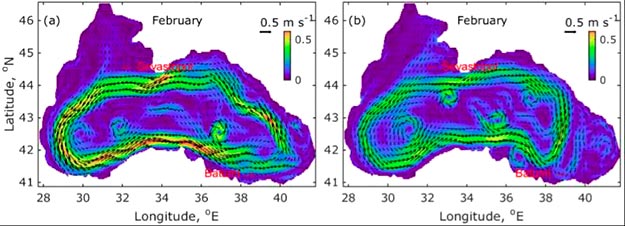Average surface temperatures of the Black Sea may not have risen, according to the surprising results of a new study from the JRC.
The study used a model to simulate possible temperature changes and predict long term trends in the Black Sea’s hydrodynamics.
While the surface showed no long term warming trend, the same simulations also indicated that average temperatures at 50 metres below the surface may be rising.
The Black Sea has unique natural conditions like a positive net freshwater balance and very specific local currents. Observational data on temperature change is varied and scarce. As such it is not clear what the impacts of climate change have been on Black Sea water temperatures.
The Sea has undergone significant ecological degradation since the 1970s, due largely to pollution, overfishing and natural climatic variations. Mapping trends in its ecosystem and simulating future scenarios is vital to understand how the Sea’s properties may develop in the future as a result of climate change and policy decisions.
Main findings
The simulations in this study, covering five decades, show no significant long-term trend in the Black Sea’s average surface water temperature. This lack of a trend is an entirely new result based on a long term simulation that had not previously been successfully conducted.
The simulation was run for the full period from 1960 – 2015 and the results were checked against known data, both from satellite information available over the last twenty years and less complete data from earlier decades.
Prior to the completion of this study, scientists had relied on sparse surface temperature data from ship cruises to understand the Sea’s properties in the earlier decades.
However, the few data points that do exist for this period have not been enough to prove a decisive trend. In fact, in the decade between 1966 and 1975 there is practically no observational data available at all.
The results of the simulation, while filling in the gaps, also came as a surprise to scientists who were expecting to see at least some warming trend between 1960 and 2015. The results also come in direct contrast to previous simulations of the nearby Mediterranean Sea, which is getting warmer.
Scientists were also surprised to find a significant decreasing trend in surface salt content of 0.02 % per year, again in direct contrast to the increasing surface salinity found in the Mediterranean. The simulations found no individual correlation between salinity and wind speed/direction, or indeed with an increase in fresh water input from the many rivers running into the Black Sea.
This suggests that combinations of weather conditions are responsible for the trend.
Furthermore, the study identifies three distinct periods in which there was a significant shift in the salt water and temperature properties of the Black Sea – 1960-1970, 1970-1995 and 1995-2015. This may be related to changes in the Sea’s currents, as the periods were also characterised by significant changes from a weak and disintegrated current circulation in the first period, to a strong main ‘Rim Current’ circulation in the second and third periods.
Over the full simulation period, the strengthening of this circulation can be seen, accompanied by intensified formation of small, localised eddies running against the current.
–The bigger picture
The Earth is getting warmer, but this isn’t happening uniformly across the planet and some regions are heating faster than others. So whilst the Black Sea might not be strongly affected, this is likely compensated by other regions which are warming at a faster rate than the globe as a whole.
For example, the sea-surface waters near Texas when Hurricane Harvey roared toward Houston were among the Earth’s warmest.
While it might sound like good news that there has been no long-term increase in the surface water temperatures of the Black Sea, this does not mean that it is unaffected by global warming. These effects may be hidden or mitigated by the fact that air temperature in the region is warming.
Indeed, the study also looked at average temperature trends at specific depths and found a positive trend at 50 metres below the surface, which suggests a warming of the deeper waters prior to the surface layer.
–Background
Several unique natural conditions of the Black Sea are well known: the so-called ‘Rim Current’ of strong water circulation around the perimeter of the Sea; the Cold Intermediate Layer (CIL) of waters below surface level; and the high level of anoxic water, which makes up over 90% of the basin’s deep water volume.
However, current knowledge about the spatial and temporal dynamics of the Black Sea’s salt content and temperature characteristics is far more limited, due to a lack of data and sparse distribution of existing measurements.
With this knowledge gap in mind, researchers at the JRC sought to develop a model able to reproduce the Black Sea’s temperature and salt-water content over the long term.
During the study, carried out as part of the EU’s Scenario simulations of the changing Black Sea ecosystem (SIMSEA) project, continuous simulations covering the period 1960-2015 were performed.
The researchers used a high-resolution General Estuarine Transport Model (GETM) with specific equations designed to accurately reproduce the main physical features of the Black Sea without relying on scarce observational and climatological data.
The study is the first successful Black Sea model based on GETM and has been published in the Journal of Geophysical Research. The successful validation and long-term application of the model used will be incorporated into future forecasts and simulations.
Source: https://www.eurekalert.org/


